Last autumn I went on a fungi foraging course in East Sussex with mycologist Geoff Dann. The group enjoyed a fascinating day of foraging and feasting on edible mushrooms whilst learning about some of the more common fungi found in Sussex and the High Weald.
Read on to discover how the day went and the fungi we found.
 Parasol mushroom
Parasol mushroom
I’ve always been intrigued by fungi. Ripples of milky white frills that appear magically overnight on an old tree stump or a mysterious fairy circle of mushrooms on a dewy autumnal morn are just fascinating.
Foraging for fungi, edible wild foods and bushcraft has become more and more popular in the UK. I live steps away from Battle Great Wood and a foray into the ancient woodland in search of fungi and wild plants is one of my favourite pastimes.
 Common Bonnets
Common Bonnets
Wild food foraging
I regularly make food from wild edibles; wild garlic pesto, blackberry vodka, elderflower cordial and bramble jelly. In a good year we also roast sweet chestnuts picked from the forest floor – one of my favourite wild ingredients. But, when it comes to fungi I’ve always been fearful.
‘Look but don’t touch’ has been my motto, but I’ve been keen to learn more. When I discovered there was mushroom foraging course near me I booked up quicker than you can say Shaggy Inkcap.
If you’re looking for a foraging book then I can recommend Geoff’s book; Edible Mushrooms, a foraging guide to the wild fungi of Britain, Ireland and Europe.
Secret foraging destination
A couple of days before the foraging course I was e-mailed directions to a woodland site a few miles north of Hastings. It was all very intriguing. I parked up on a brisk Sunday morning in November and followed the route to our secret meeting place in the woods.
A tarpaulin was rigged up to shelter us from the rain, which fortunately, didn’t last long. A circle of logs and low stools were arranged under the shelter and a warming camp fire crackled nearby.
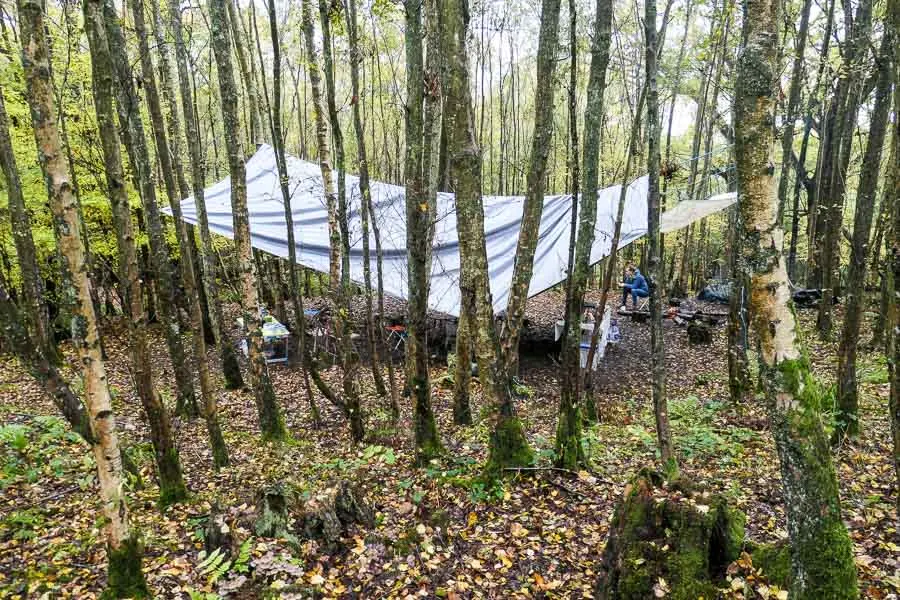 Our foraging base camp
Our foraging base camp
There were around ten people in the group all eager to learn more about foraging. Some had a little experience and others, like me, were complete novices.
We’d been asked to bring some foraged fungi with us and a long table displayed the myriad of mushrooms and fungi we’d sought out.
Geoff began the foraging course by introducing each species – these included many that he’d recently foraged.
From huge field mushrooms and parasols to boletes, blewits and penny buns on the edible end of the spectrum to fly agaric, deathcaps and deceivers on the dodgy end.
Learning about fungi
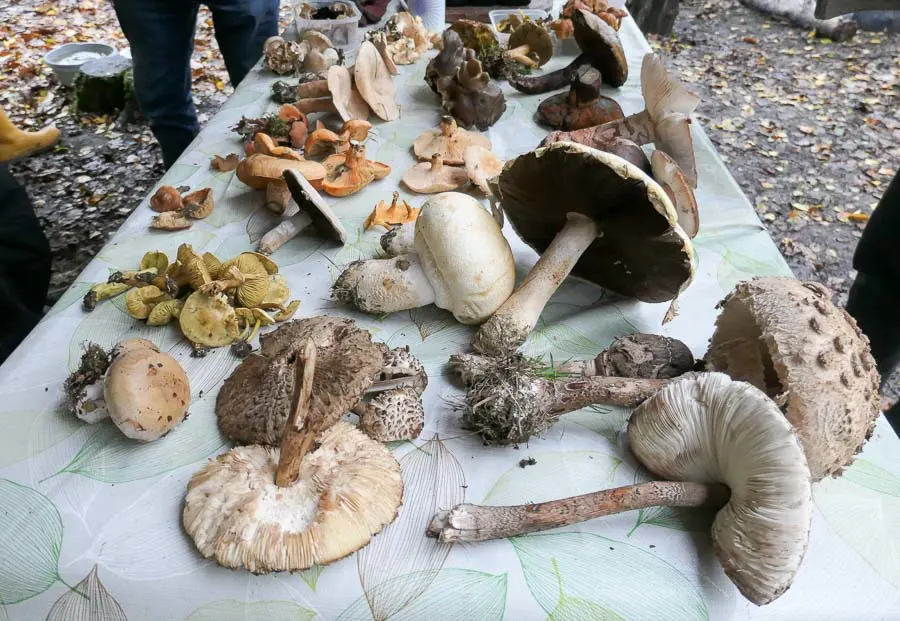 Fungi foraged in East Sussex
Fungi foraged in East Sussex
The difference in size, colour and shape is vast. We started with the poisonous corner. It turned out that most of the ones I’d brought along were either inedible, poisonous or deadly. I was wise to stick to my motto!
We spent around half an hour learning about our foraged finds. The different parts of the fungi; what to look for on the stem, the gills, the cap and other identifying features like the smell, the colour and pores.
Many of the edible fungi have an evil twin – a very similar looking poisonous counterpart. Before you even touch fungi you need to know your stuff.
There’s a lot to learn when it comes to fungi and these foraging courses are just a taster. I don’t recommend ever picking and eating fungi unless you know exactly what you’re doing or have an expert mycologist like Geoff at hand.
Don’t ever ‘pick and hope’. They don’t have names like Funeral Bell, Deathcap, Destroying Angel or Deadly Webcap for nothing…
If you’re looking for a foraging book then I can recommend Geoff’s book; Edible Mushrooms, a foraging guide to the wild fungi of Britain, Ireland and Europe.
The first forage
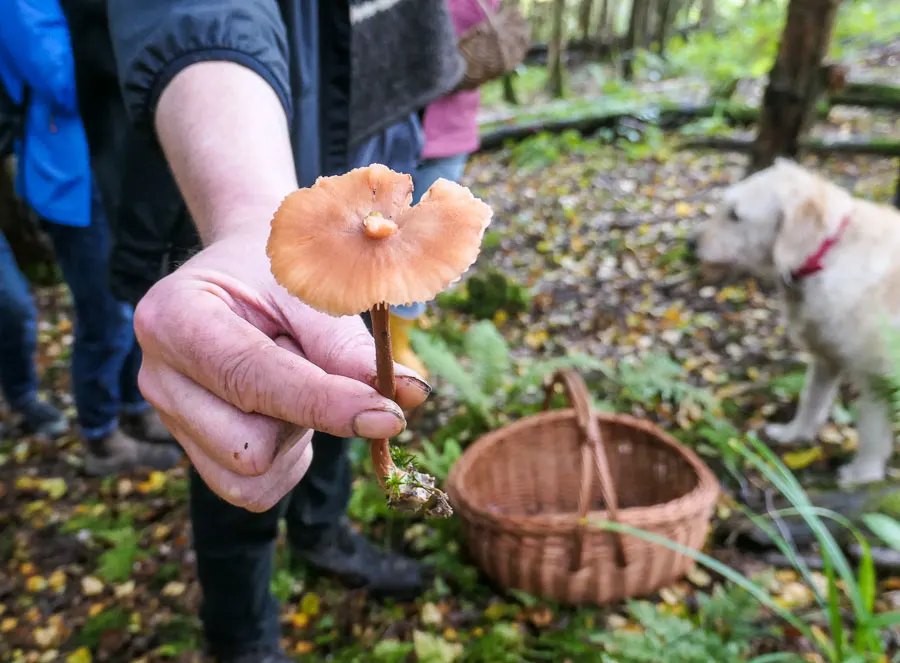
It was time to head into the forest for our first foraging walk. Within a few steps we found a mossy stump swathed in honey fungus. It was very pretty to look at but we were after better species. It wasn’t long before we found them – lots of them.
There are around 60 species of edible wild fungi in the 20-acres of woodland and nearby fields around the camp. We gathered all kinds of edible fungi from boletes and blewits to hedgehog mushrooms, oyster mushrooms, jelly ear, trooping funnels and many more.
Each time we found a new fungi Geoff would explain which characteristics to look for and how to identify it. He’d also tell us about similar looking poisonous or deadly fungi and how to differentiate between the two.
We switched from forest to field and came across some large, white, flat-capped mushrooms. Geoff asked us what they were. They looked like common field or macro mushrooms which is what we guessed.
Geoff picked one and sliced the cap with his knife. It quickly started to turn an acrid yellow – these innocent ‘everyday’ looking mushrooms were actually the poisonous Yellow Stainer.
The Country Code
Geoff’s foraging courses are based around safe and sustainable practises. We followed the code of conduct for mushroom pickers by leaving at least half the fungi behind in any one location. Singletons were left alone and mature fungi past their best were left too.
We didn’t trample and didn’t pick any rare species. Not difficult because we didn’t actually find any. Remember to close gates, don’t disturb livestock and don’t litter.
If you’re looking for a foraging book then I can recommend Geoff’s book; Edible Mushrooms, a foraging guide to the wild fungi of Britain, Ireland and Europe.
Lunch – mushroom soup, a tart and jammy dodgers
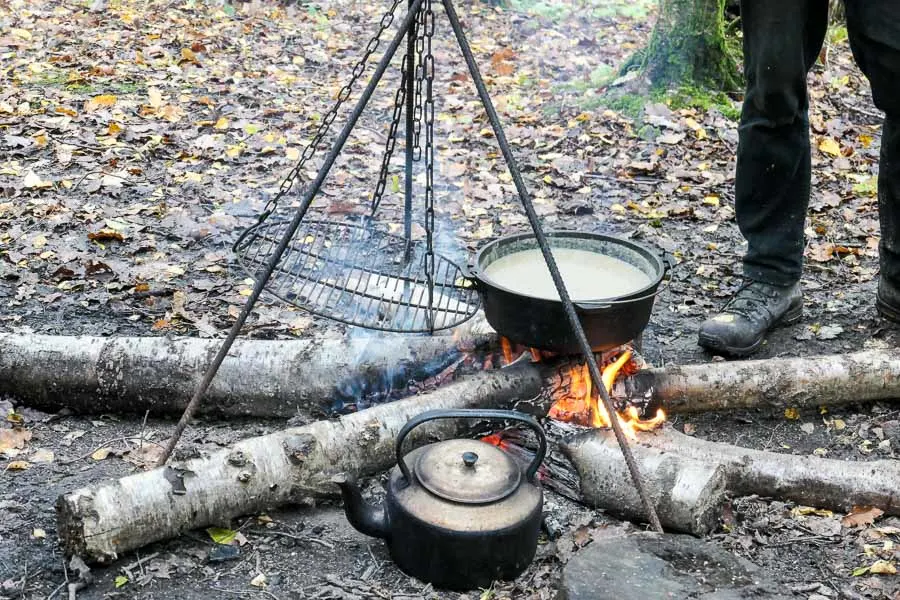 Cathy’s mushroom soup
Cathy’s mushroom soup
Back at camp a home-made foraged lunch and a cup of tea, herbal or otherwise, was waiting for us. Geoff’s wife, and cook for the day, Cathy, had a cauldron of mushroom soup simmering over the camp fire.
The soup is made with around 60% parasol mushrooms plus penny bun, saffron milkcap and blusher cooked up with onions and garlic in olive oil. Vegetable stock is added and simmered and then all blended when ready. Add cream at the end for a deliciously warming, very tasty soup served with fresh bread. Leave out the cream if you’re vegan.
A colourful home-made tart of foraged mushrooms followed and for dessert there were jammy dodgers. The best jammy dodgers I’ve ever tasted, made by Cathy with acorn flour and filled with rosehip and service tree jelly.
The biscuits were deliciously nutty and not too sweet and the flavour reflected all the hard work that had gone into making them. We were very well fed.
If you like eating locally sourced food then you’ll love our Sussex Smokie recipe.
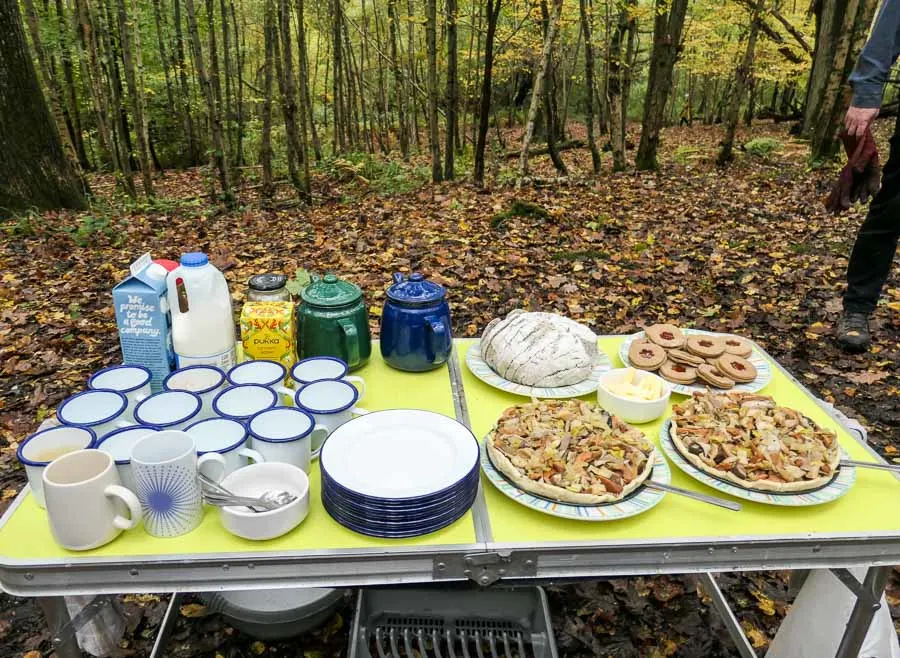 A foraged lunch with mushroom soup, mushroom tart, bread, butter and jammy dodgers – it doesn’t get any better than this!
A foraged lunch with mushroom soup, mushroom tart, bread, butter and jammy dodgers – it doesn’t get any better than this!
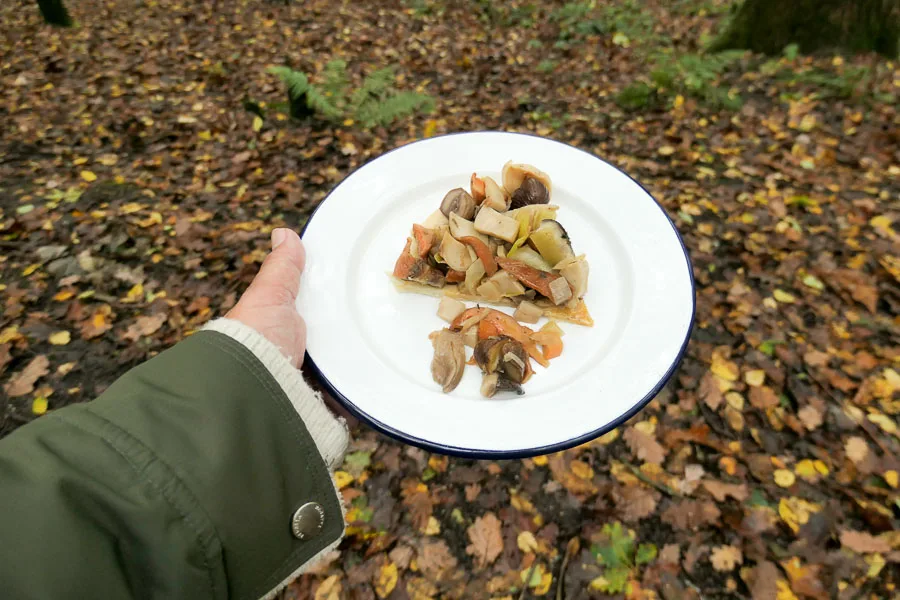 Mushroom tart with foraged mushrooms
Mushroom tart with foraged mushrooms
A second forage
After lunch we set out on a second forage to a different, wilder, part of the woods. This area of woodland was more dense with steep ghylls, streams and small waterfalls.
More wood blewits were added to the basket and we learned about puffballs, earthballs and another type of fungi, the Birch polypore. This large bracket fungus can be used to create a makeshift plaster to cover a small cut or graze by peeling away a strip of the cap.

Feasting on edible fungi
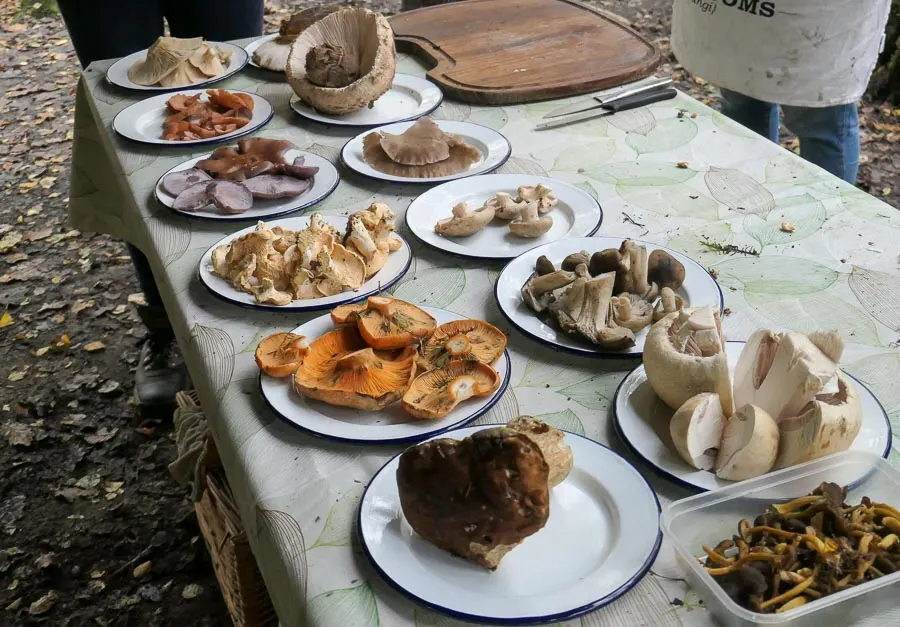 A selection of foraged mushrooms
A selection of foraged mushrooms
We headed back to camp to sample our foraged fare from both outings together with the edible fungi everyone had brought along.
The fungi is chopped up and sautéed in butter over the camp fire. We all have a mouthful or two of around six different mushrooms. It was interesting to compare flavours which, along with the textures, are all quite distinct and vary greatly. The hedgehog mushrooms and trooping parasols were especially tasty.
My thoughts on Geoff’s fungi foraging course
For anyone looking for a safe, fun, day’s foraging these events are a fabulous experience. You’ll learn a lot about edible fungi and foraging from Geoff’s extensive knowledge and get to taste some wonderful wild food foraging from the High Weald.
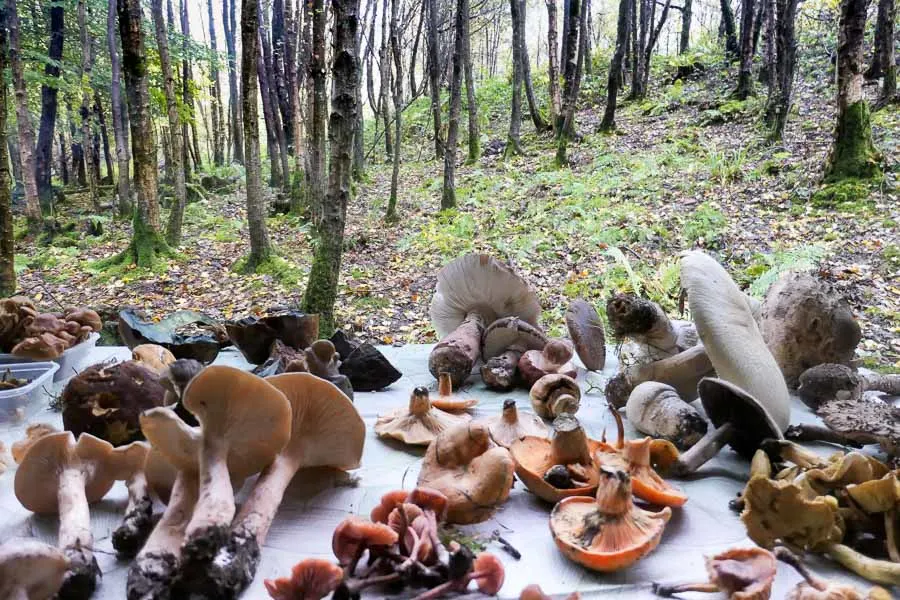
****Please note that since Geoff has moved to Wales and he is no longer running foraging days in Sussex. Details of his courses in Wales can be found on Geoff’s Fungi and Foraging website.
Foraging courses in Sussex
For foraging courses in Sussex you might want to take a look at Foraging with Fern. or check out this foraging day on Saturday 26th August via Resident Artisan near Midhurst.
All things Fungi Festival
All Things Fungi is a fungi festival taking place in Chiddinglye, East Sussex in September 2023.
Edible Mushrooms – the book
If you’re looking for a foraging book then I can recommend Geoff’s book; Edible Mushrooms, a foraging guide to the wild fungi of Britain, Ireland and Europe. The book published in 2016, is the most comprehensive book available on British and northern European fungi foraging and a must-have for any forager worth their salt.
I’ve bought myself a copy have found it useful as well as fascinating. It costs around £20 here although prices vary. You can also buy directly from Geoff if you attend the course. It’s a very comprehensive book and quite weighty. If you want a book that’s practical to actually take out foraging then opt for a handbook which will be lighter to carry.
About Geoff Dann
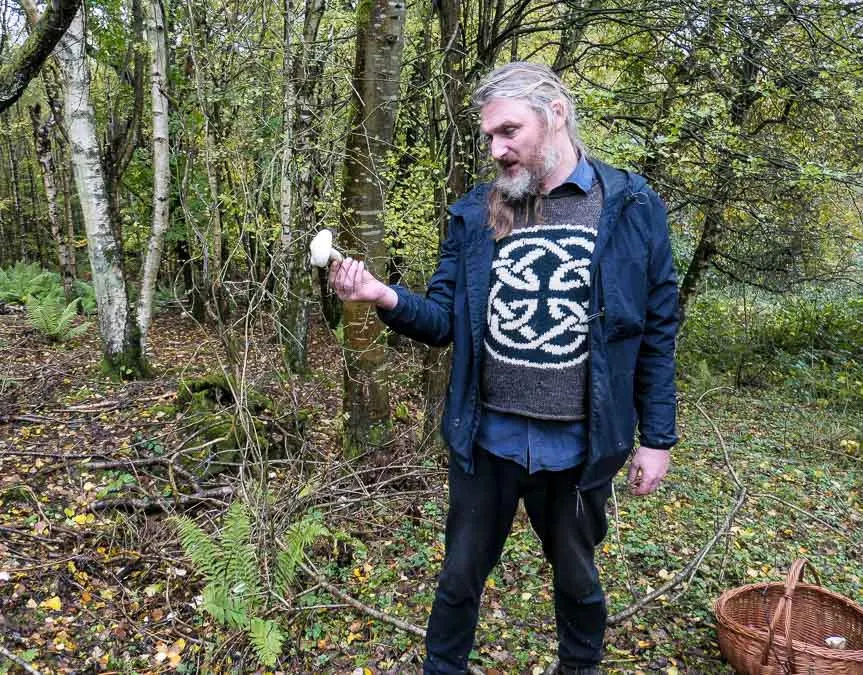 Geoff Dann, Mycologist
Geoff Dann, Mycologist
Geoff is a fungi specialist, known as a mycologist, and professional forager. He teaches groups and runs foraging courses for fungi, plants and seaweeds. He’s been fascinated by fungi since his teens and made it his mission to seek out every species of edible, poisonous and common fungus in Sussex.
Geoff led his first fungi foraging course in September 2009 and since then things have, err, mushroomed. He now leads numerous foraging days throughout the autumn in and around the south east of England. Geoff’s second book, about edible plants and seaweeds, is due for release.
Are you a keen forager? What and where in Sussex do you like to forage?
Pin it!

Suzanne Jones is owner and editor at Hello Sussex which was founded in 2017. When she’s not exploring Sussex or writing about it you’ll most likely find her, camera in hand, enjoying coastal and countryside hikes across the county.
Suzanne is also travel writer and content creator at top travel blog The Travelbunny which she founded in 2011.

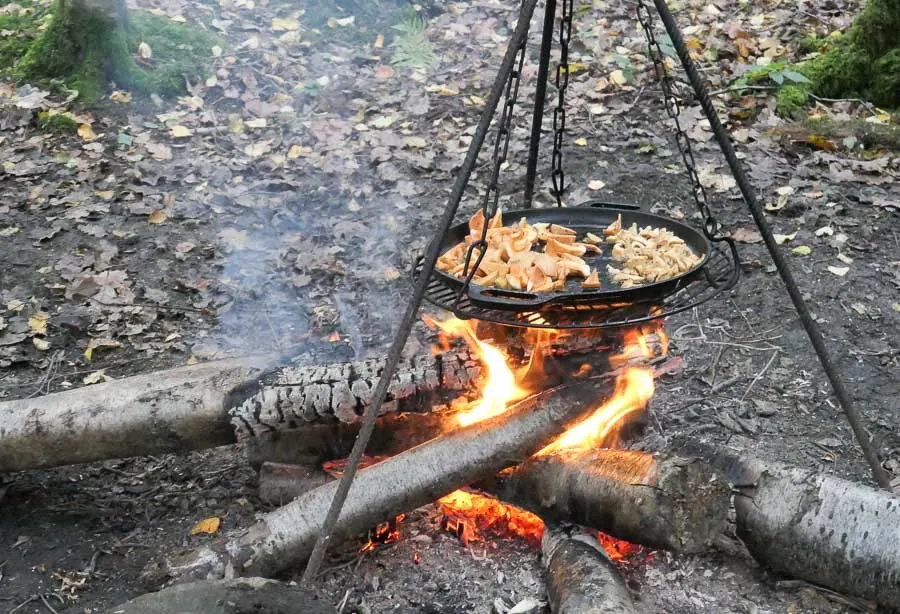



LIZE McCarron
Wednesday 7th of September 2022
When’s the next one
Suzanne Jones
Wednesday 7th of September 2022
Hi Liz, I believe Geoff Dann has recently moved to Wales. However, you may find a course in Sussex with Fern. Please see website https://www.foragedbyfern.com/foraging-courses-sussex
Charles Purssey
Thursday 19th of May 2022
You pulled the base of the parasol out, I was always told to twist the stem so as not to pull the whole thing out.
Suzanne Jones
Thursday 19th of May 2022
I didn't pick the parasol - Geoff did...
Karen Tilley
Tuesday 19th of October 2021
I would love to do a course on mushroom foraging with my Son Alfie. He is already a foraging fan but I would like him to learn more about mushrooms and keep safe.
Suzanne Jones
Tuesday 19th of October 2021
It's a mushroom minefield out there! There's so much to learn and a day's foraging course is just the tip of the iceberg! Geoff's course is a fabulous place to start learning
Kathryn Burrington
Monday 26th of April 2021
This looks great fun. I love foraging but have steered clear of mushrooms. This might give me the confidence to start although even if I didn't ever pick them again, I'd still love to join this course for the day!
Alex Stone
Sunday 21st of November 2021
Looks really interesting. Do you have a site to sign up to?
Suzanne Jones
Wednesday 5th of May 2021
It's a fabulous day course and I highly recommend it. There's so much to learn about fungi that you'd never remember them all but it's a good place to start!